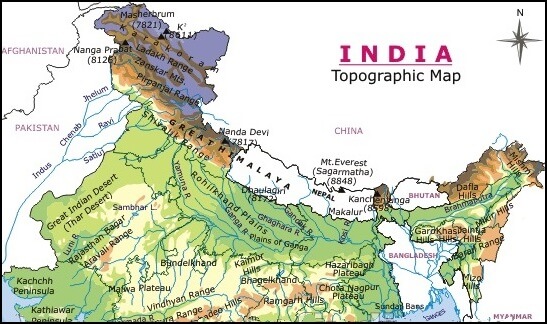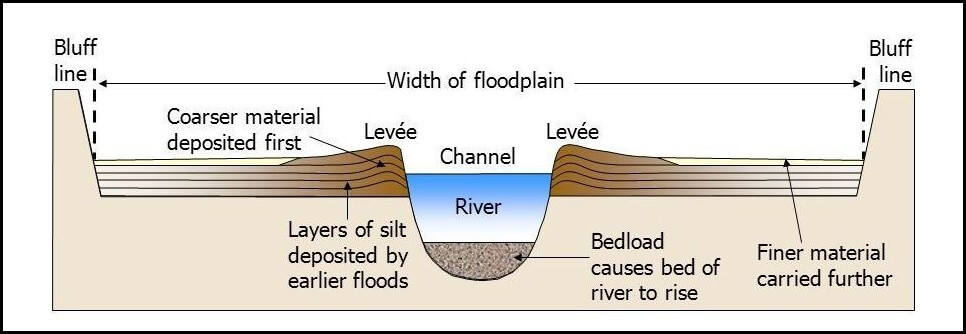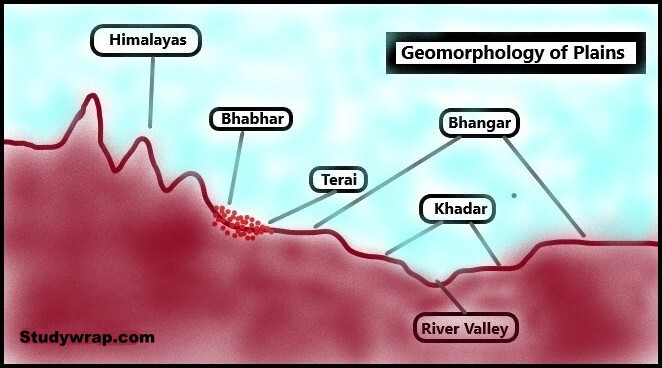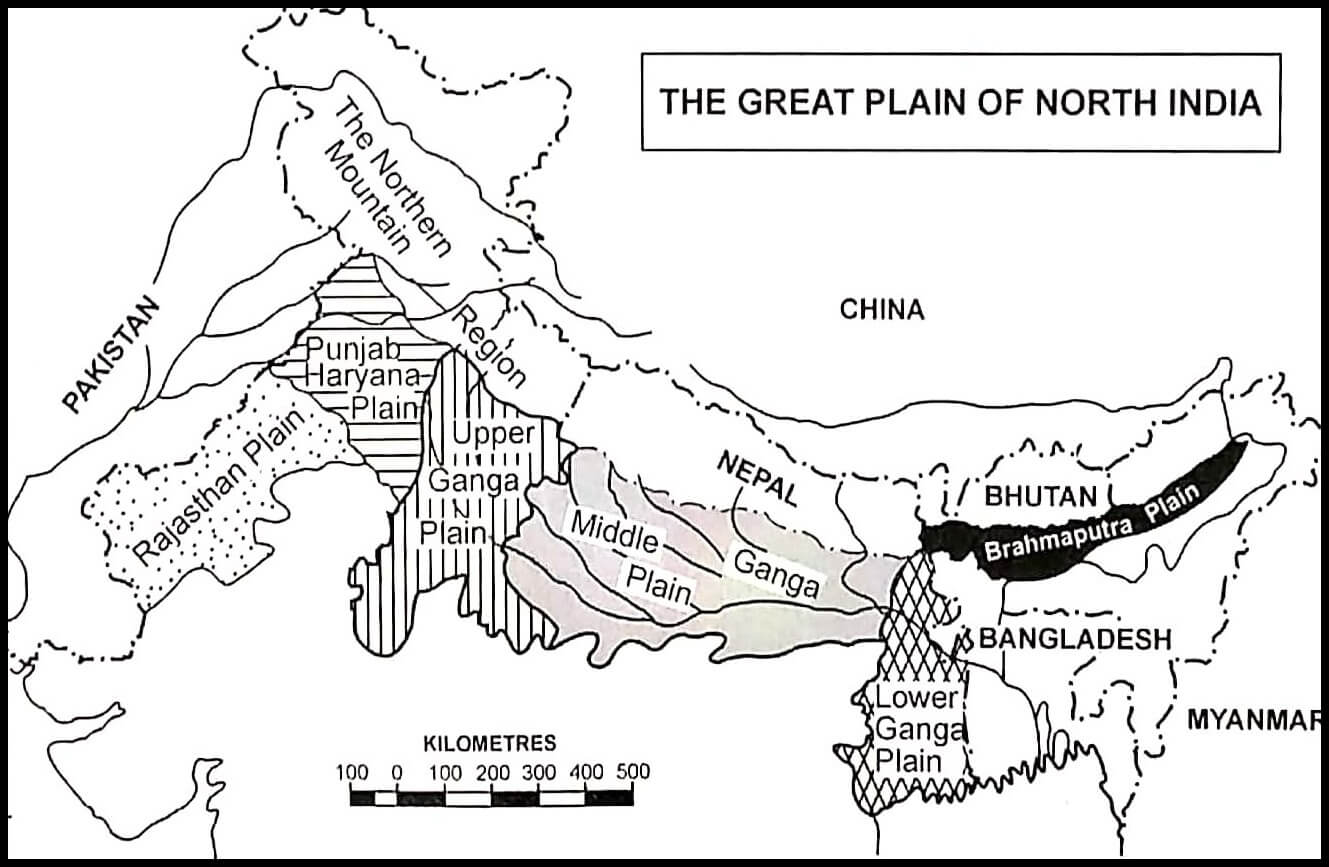Geography
The Northern Plains of India (Great Plains of India)
The Great Plains of India
Table of Contents
- The Northern Plains of India lie to the south of Shiwalik separated by the Himalaya by the Himalayan front fault.
- It is transitional zone between the Himalayan of the north and peninsular India of the south.
- It is the plain formed by the alluvial deposit of Ganga, Brahmaputra, Indus and their tributaries.
- Plains stretches to about 2400 km from west to east.
- It has varying width 90-100 km in Assam, 160 km in Jharkhand, 200 km in Bihar, 280 km in Allahabad, 500 km in Punjab. Which increases with movement from east to west.
- The plains largely consist of alluvial deposit brought down by rivers originating in Himalaya and peninsular region.

- Plains are remarkably homogeneous with little variation in relief features.
- The monotony is broken by the rivers bluffs, Bhurs, levees, dead arms of river channels, the riverine and the Khols.
- Changing river course in the area of frequent flood is a unique geomorphic process.
Origin of Northern Plains of India
- There is no unanimity amongst the geologist about the origin of The Northern Plains of India.
- The puzzling questions related to the enormous thickness of the alluvium nature of the diffraction, mode of its formation, subterranean beds and underlying geological structure.
- Some of the important views about origin of Northern Plains are-
1. Alluviation Of The Foredeep
-
-
- According to this view by Austrian geologist Edward Suess, a foredeep was formed in front of the high crust waves of Himalaya.
- Foredeep is sediment filled sea floor depression.
- River descending from Himalayan region carried sediments and filled the foredeep leading to the formation of alluvial plain. The bed of this Foredeep has a gentle slope towards the North side while the peninsular side depicted steep gradient.
-
2. In Filling Of The Rift Valley
-
-
- As per this view by Sir Sydney Burrand, large rift was accompanied the formation of Himalaya between two parallel faults, one along Southern boundary of Shiwalik and other along the northern boundary of Peninsula.
- The rift valley was infilled by the sediments brought down by the rivers. Hence resulted in formation of plains.
- However, this theory is not accepted by Geological Survey of India.
-
3. Remnant Of Tethys Sea
-
-
- According to this view, after the sudden disruption or upheaval of Shiwaliks, the remaining part of the Tethys Sea was left as a large trough joined by Bay of Bengal in the East and Arabian Sea in the west.
- Rivers from the Himalayan range deposited their sediments in this trough. Due to the infilling of the central part of the sea located in the west and the east started receding and northern plains came into existence.
-
4. Recent views
-
-
- According to recent views, the northern plains are a sag in the crust formed between the northward drifting of the Indian subcontinent and comparatively soft sediment accumulated in the Tethys basin.
- When the latter were crumpled and lifted up into a mountain system, subsequently they were filled by water or river deposits.
-
Formation of Indo – Gangetic Brahmaputra Plain
- The formation of Indo gangetic Brahmaputra plain is closely related to formation of Himalaya.

Formation of Indo gangetic Brahmaputra trough
-
- The rivers which were previously going into Tethys Sea (before Indian plate collides with Eurasian plate- continental drift) deposited huge amount of sediments in the Tethys Geosynclinal.
- Himalayas are formed out of the sediment which were uplifted, folded and compressed due to the northern movement of Indian plate.
- Northern movement of Indian plate also created a trough to the southern Himalaya.
Depositional activity
-
- During the initial stage of upliftment of sediments, the already existing rivers change to their path several times and they were rejuvenated each time.
- The rejuvenation associated with intense headward and vertical down-cutting of the soft strata lying over the inner hard rock system.
- Headward erosion- erosion of the origin of the stream channel, which causes the origin to move back away from the direction of the stream flow and so caused the stream channel to Lengthen.
- Headword and vertical erosion of the river valley in initial stages, lateral erosion in later stages contributed to huge amount of conglomerates (rock the place, clay, silt etc.) which were carried down slope.
- These Conglomerates were deposited in the depression (indo gangetic trough) between peninsular India and the convergent boundary. The base of the geosyncline is a hard crystalline rocks.
New rivers and more alluvium
-
- The rising of Himalaya and subsequent formation of glaciers give rise to many new rivers. These river along with the glacial erosion supplied more alluvium which intensified the filling of the depression.
- With the accumulation of the more and more settlement, the Tethys Sea started reducing.
- With passage of time, the depression was completely filled with alluvium, gravel, Rock debris and Tethys Sea completely disappeared leaving behind monotonous plains.
- Upper Peninsula Rivers have also contributed to the formation of plains but to very small extent.
- Recent times (i.e. few million years ago) depositional work of three major river system i.e. The Indus, the Ganga and the Brahmaputra have become predominant.
- Hence, this arcuate (curved) plains is known as Indo gangetic Brahmaputra plains.
Features of Indo Gangetic Brahmaputra Plain
-
- Largest alluvial tract in the world.
- Stretches for about 3200 km, from the mouth of Indus River to the mouth of Ganga. Indian sector of the plain accounts for 2400 km.
- The northern boundary is well marked by the Shiwaliks and the southern boundary is wavy, irregular line of the northern edge of the peninsular plateau.
- The Western border is marked by Suleman and kirthar range. On the eastern side the plains are bordered by Purvanchal Hills.
- Width of plain varies from region to region. It is widest in the west where it is stretches for about 500 km. Its width decreases in East.
- The thickness of the alluvial deposits also varies from place to place. The maximum depth of the alluvial plain up to the basement of rock is about 6100 m which is not uniform and varies greatly.
- The cones of alluvial fan of Kosi in the north and those of Son in the south exhibit greater alluvial deposit or thickness while the intra cone areas have relatively shallow deposits.
- Extreme horizontality of this monotonous plains is its chief characteristic.
- Average elevation is about 200 m above mean sea level, highest elevation being 291 m above mean sea level near Ambala. (This elevation forms the drainage divide between Indus system and Ganga system).
- Its average gradient from Saharanpur to Kolkata is only 20 cm per km and it decreases 15 cm per km from Varanasi to Ganga delta.

-
- The monotony of the physical landscape is broken at the micro level by The river bluffs, levees etc. –
-
- Floodplains- the part of river valley adjacent to the river channel, over which river flow in time of flood.
- Levee- an elevated Bank flanking the channel of the river and standing above the level of the flood plains.
- Bluff- A river cut cliff or steep slope on the outside of the meander. Line of bluffs often marks the edge of former flood plains.
-
- The monotony of the physical landscape is broken at the micro level by The river bluffs, levees etc. –
Geomorphological Features of Northern Plains of India
- From north to south Northern Plains of India can be divided into the three major zones –
-
-
- The Bhabar
- The Tarai
- The Alluvial Plains
-
- The Khadar
- The Bhangar
-
-
-

The Bhabar
-
- Narrow and porous, northernmost stretch of Indo gangetic plain.
- It is about 8-16 km wide running in east west direction along the foothills of Shiwalik.
- Shows remarkable continuity from Indus to Tista.
- Rivers descending from Himalaya deposit their load along the foothill in the form of alluvial fan.
- Alluvial fans have merged together to build up bhabar belt.
- The porosity of Bhabar its most unique feature.
- The porosity is due to the deposition of huge number of pebbles and rock debris across the alluvial fan.
- The stream reaches disappear once there reach the bhabar region because of this porosity.
- The area is marked by dry river course except in rainy season.
- The bhabar belt is comparatively narrow in East and extensive in west and North Western Hilly region.
- This area is not suitable for agriculture only Big trees with large and deep roots thrives in this belt.
The Terai
-
- It is ill drained, damp (marshy) and thickly forested narrow tract to the south of bhabar running parallel to it.
- About 30 km wide.
- The underground stream of Bhabar re-emerge in this belt.
- The thickly forested region provides shelter to the variety of wildlife.
- Tarai is more marked in Eastern part then in western part because Eastern part receive comparatively more rainfall.
- Most of the Tarai land of especially Punjab, Uttar Pradesh, and Uttarakhand has been converted to agricultural land giving good crop of sugarcane, rice and wheat.
The Bhangar
-
- It is the older alluvium along the river bed forming terraces higher than floodplain.
- The terraces are often impregnated with calcareous concentration known as Kankar.
- The plains in the delta region of Bengal and bhur formation in middle Ganga and Yamuna doab are regional variation of Bhangar.
- Soil is dark in colour, rich in humus content and productive. The soil is clayey in composition and has lime modules.
- Bhur denotes an elevated piece of land situated along the banks of the Ganga River especially in the upper Ganga Yamuna doab. This has been formed due to accumulation of wind blowing sands during hot dry month of the year.
- Bhangar contains fossils of animal and plants.
- In relatively drier areas, the Bhangar also exhibit small tract of saline and alkaline efflorescence known as ‘Reh’, ‘Kallar’ or ‘Bhur’. ‘Reh’ areas have spread in recent time with increase in irrigation.
The Khadar
-
- Khadar is composed of newer alluvial and forms the flood plain along the river.
- A new layer of alluvial is deposited by river almost every year.
- This makes them most fertile land or soil of Ganga.
- Light in color, sandy in texture and more porous. Found near river bed.
- In Punjab, the Khadar rich flood plains are known as ‘Betlands’ or ‘Bets’.
- The river in Punjab and Haryana plains have broad flood plains of Khadar flanked by bluffs, locally known as Dhayas. They can be as high as 3 m.
Regional Division of Northern Plains of India
- Regionally, The Northern Plains of India have been divided into –
-
-
- Sindh plains
- Rajasthan plains
- Punjab plains
- Ganga plains
- Brahmaputra plain
- Ganga Brahmaputra delta
-
-

Sindh Plain
-
-
- Lies in Pakistan.
- Mainly formed of Bhangar plains.
- Dhors – long narrow depression which are remnant of course of former rivers.
- Dhand – Alkaline lakes on some Dhors.
-
Rajasthan Plain
-
-
- Occupied by Thar or Great Indian Desert.
- This plain is undulating plain i.e. Wave like structure, whose average elevation is about 325 m above sea level.
- The desert region is called ‘Marusthali’ and forms great part of Marwar region.
- It has few outcrops of gneisses, schists and granites, which proves that geologically it is a part of Peninsular plateau. It is only at the surface that it looks like aggradational plain.
- In general, the eastern part of Marusthali is rocky while its western part covered by shifting sand dunes locally known as
- The eastern part of the Thar Desert upto Aravalli range is semi-arid plain known as Rajasthan Bangar.
- It is drained by numerous seasonal short streams originating from Aravalli and support agriculture in some patches of fertile land.
- Luni is an important seasonal stream which flows in Rann of Kutch. The tract north of Luni is known as Thali or sandy plains.
- North of Luni, there is inland drainage having several saline lakes which are source of several types of salt. Eg. Sambhar, Didwana etc.
-
Punjab Plains
-
-
- This plain is formed by five important rivers of Indus system.
- The plain is primarily made up of doabs – ‘the land between two rivers’.
- The depositional process by the river has united these doabs giving homogeneous appearance.
- Punjab literally means ‘The land of five rivers’ referring to following rivers – Jhelum, Chenab, Ravi, Satluj and Beas.
- Total area of this plain – about 1.75 sq. km
- Average elevation of the plain – 250 m above mean sea level.
- Eastern boundary of Punjab and Haryana plain is marked by sub surface Delhi-Aravalli Ridge.
- The northern part of this plain has been intensely eroded by numerous streams called. ‘Chos’. This has led to enormous gullying.
- To the south of Sutlej River there is Malwa plains of Punjab.
- The area between Ghaggara and Yamuna River lies in Haryana and often termed as ‘Haryana Tracts’. It acts as water divide between Yamuna and Satluj River.
- The only river between the Yamuna and Satluj is Ghaggara which is considered to be present day successor of the legendary Saraswati River.
-
Ganga Plains
-
-
- This is largest unit of the Northern Plains of India stretching from Delhi to Kolkata.
- The Ganga along with its largest number of tributaries originating in Himalaya have brought large quantity of alluvial from mountains and deposited it here to build the extensive plains.
- The peninsular rivers such as Chambal, Betwa, Ken, Son etc. Joining the Ganga river system have also contributed to the plain formation.
- The general slope of entire plain is to east and south east.
- River flow sluggishly in the lower section of Ganga as a result of which area is marked by prominence such as levees, bluffs, oxbows, lakes, marshes, ravines etc. ( Fluvial landform, arid landform)
- Almost all the rivers keep on shifting their courses making this area prone to frequent floods. The kosi ricer is very notorious in this respect and long been known as ‘Sorrow of Bengal’.
- Regional division of Ganga plains –
-
- Rohilkhand plains
- Avadh plains
- Mithila plains
- Magadh plains
-
-
Brahmaputra Plains
-
-
- Also known as Brahmaputra valley or Assam Valley or Assam plains as most of the Brahmaputra valley is situated in Assam.
- Its western Boundary is formed by the Indo Bangladesh border as well as the boundary of the lower Ganga plains. Its eastern boundary is formed by Purvanchal Hills.
- It is an aggradational plains build up by the depositional work of Brahmaputra and its tributaries.
- The innumerable tributaries of the Brahmaputra River coming from north form a number of alluvial fans. This results in branching out of tributaries in many channels giving birth to river meandering leading to the formation of bills and oxbow lakes.
- There are large marshy tract in this area. The Alluvial fans formed by the coarse alluvial debris have led to the formation of Terai or Semi- Terai condition.
-
Ganga-Brahmaputra Delta
-
-
- Largest delta in the world.
- Ganga River divide itself into several channels in the delta area. The slope of land here is 2 cm per km. Two third of area is below 30 m above mean sea level.
- The seaward face of delta is studded with large number of estuaries, mud flats, mangroves, swamps, Sandbanks Island and forelands.
- Large part of the coastal delta is covered by tidal forest which is called Sundarban.
- They are called Sundarban because of predominance of sundari tree here.
-
Significance of the Northern Plains of India
-
- This one fourth of land of country hosts half of India’s population.
- Fertile Alluvial soil, flat lands, slow moving perennial rivers, and favourable climate facilitates intense agricultural activities.
- Extensive use of irrigation of Punjab and Haryana and western part of Uttar Pradesh the granary of India.
- The entire plain except the Thar Desert has closed network of roads and railways which has led to large scale industrialisation and urbanization.
- Cultural tourism- there are many religious places along the bank of river Ganga and Yamuna which are very dear to Hindus. Everest the religion of Buddha and Mahavir and the moment of bhakti and Sufism.
- The sedimentary rocks of plains have petroleum and natural gas deposits.
- The river have very gentle gradient which makes them navigable for long distance.
That’s it for this post on The Great North Indian Plains or The Northern Plains of India.
In the next post (Click here), we would learn about the peninsular Plateau region of India.


Thank you so much for the notes … Very helpful
Nice notes. Can you please upload more notes..??
Thanks for sharing this wonderful article with us thanks.
I am interested in more info.